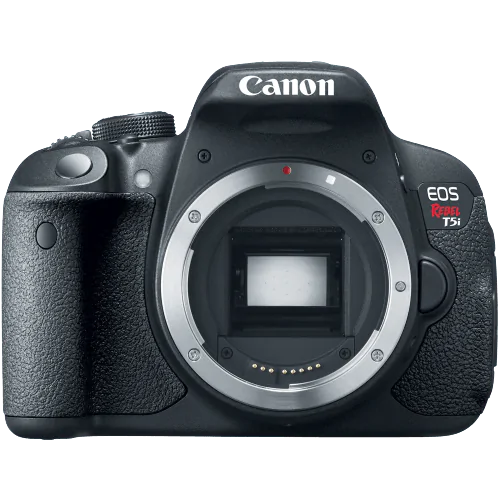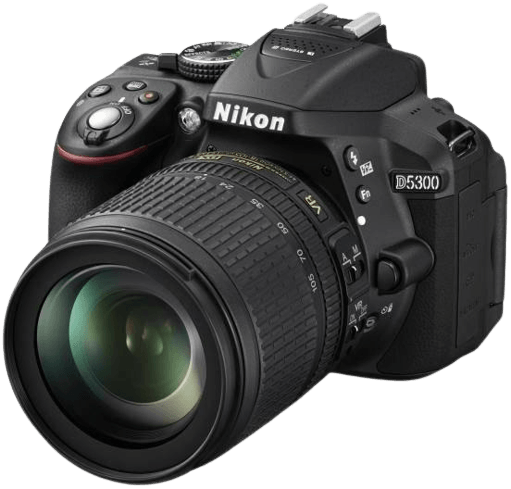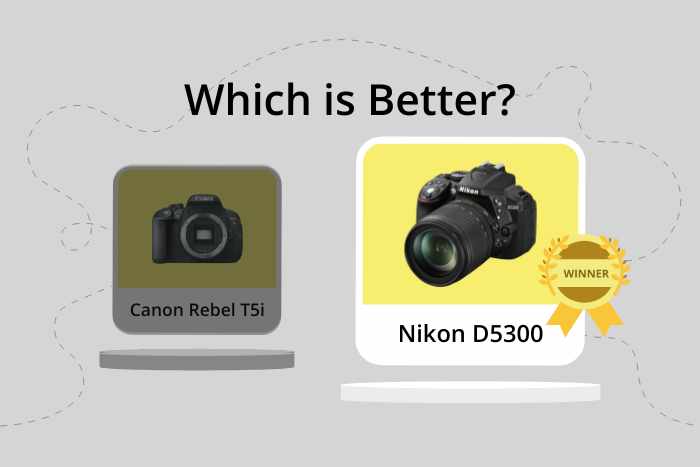Canon EOS Rebel T5i / 700D vs Nikon D5300 Comparison
Canon EOS Rebel T5i / 700D

Nikon D5300

The Nikon D5300 outperforms the Canon EOS Rebel T5i / 700D with a score of 57/100 compared to the Canon’s 44/100. Both cameras are DSLR models released in 2013, with the Nikon D5300 priced slightly higher at $800, while the Canon T5i was launched at $750. They share similar dimensions, with the Nikon being a bit smaller at 125 x 98 x 76mm, compared to the Canon’s 133 x 100 x 79mm.
The Nikon D5300 is better in terms of weight, as it is lighter at 480g or 1.06lbs, while the Canon T5i weighs 580g or 1.28lbs. This makes the Nikon more convenient for carrying around during photography sessions. On the other hand, the Canon T5i has no significant advantages over the Nikon D5300 in terms of general specifications.
Taking into account their scores, dimensions, and weight, the Nikon D5300 is the superior choice between these two cameras, offering a lighter and more compact option for photographers.
Canon EOS Rebel T5i / 700D vs Nikon D5300 Overview and Optics
The Nikon D5300 outperforms the Canon EOS Rebel T5i / 700D in optics, scoring 65/100 compared to the Canon’s 40/100. Both cameras share common specifications such as a CMOS sensor, 5 fps shooting speed, APS-C sensor size, and no image stabilization.
The Nikon D5300’s superiority in optics is evident in its higher megapixel count of 24.2, compared to the Canon’s 18 megapixels. This allows the Nikon D5300 to capture more detail and produce higher resolution images. Furthermore, the DXOMARK score for the Nikon D5300’s sensor is 83, significantly higher than the Canon’s score of 61. This indicates that the Nikon D5300 has better overall image quality, dynamic range, and low-light performance. The Nikon D5300 also has the advantage of an Expeed 4 processor, which is more advanced than the Canon’s Digic 5 processor.
While the Canon EOS Rebel T5i / 700D has a lower score in optics, it still offers a solid performance with an 18-megapixel sensor and a Digic 5 processor. The Canon EF-S lens mount provides access to a wide range of Canon lenses, allowing for versatility and adaptability in various shooting situations.
Taking these factors into account, the Nikon D5300 proves to be the stronger contender in terms of optics, with a higher megapixel count, better sensor performance, and a more advanced processor. The Canon EOS Rebel T5i / 700D, although inferior in this aspect, still provides a satisfactory performance and a versatile lens mount.
Canon EOS Rebel T5i / 700D vs Nikon D5300 Video Performance
The Nikon D5300 emerges as the superior camera in terms of video capabilities, with a score of 70/100 compared to the Canon EOS Rebel T5i/700D’s score of 43/100. Both cameras share some common specifications: they have a maximum video resolution of Full HD and maximum video dimensions of 1920 x 1080. However, there are distinct differences that set the Nikon D5300 apart.
The Nikon D5300 boasts a higher maximum video frame rate of 60fps, whereas the Canon EOS Rebel T5i/700D has a maximum of 30fps. This higher frame rate allows the Nikon D5300 to capture smoother and more detailed video, especially during fast-paced action or movement. Additionally, the Nikon D5300 has built-in time-lapse functionality, enabling users to create stunning time-lapse videos without the need for external accessories or software. The Canon EOS Rebel T5i/700D lacks this feature.
While the Canon EOS Rebel T5i/700D falls short in comparison to the Nikon D5300, it still offers decent video capabilities for casual users and beginners. Its Full HD video resolution and 30fps frame rate are sufficient for capturing everyday moments and sharing on social media platforms. However, for those seeking more advanced video features, the Nikon D5300 is the clear winner.
Considering the significant difference in video scores and the additional features available in the Nikon D5300, it is evident that this camera outperforms the Canon EOS Rebel T5i/700D in terms of video capabilities. The Nikon D5300’s higher frame rate and built-in time-lapse functionality make it the superior choice for those prioritizing video performance in their camera selection.
Canon EOS Rebel T5i / 700D vs Nikon D5300 Features and Benefits
The Canon EOS Rebel T5i / 700D outperforms the Nikon D5300 with a feature score of 57/100 compared to 46/100. Both cameras share several specifications, including a flip screen and the absence of Bluetooth connectivity. However, the Canon T5i has certain advantages over the Nikon D5300, while the latter also boasts some stronger features.
The Canon T5i has a touchscreen with a resolution of 1,040,000 dots, which is slightly higher than the Nikon D5300’s non-touchscreen resolution of 1,037,000 dots. The touchscreen allows for easier navigation and control, giving the Canon T5i an edge in user experience. However, the Nikon D5300 has a larger screen size of 3.2 inches compared to the Canon T5i’s 3-inch screen.
The Nikon D5300 surpasses the Canon T5i in terms of connectivity, offering both GPS and Wi-Fi capabilities. The GPS function enables geotagging of images, while the Wi-Fi allows for easy sharing of photos and remote control using a smartphone. The Canon T5i lacks both these features, which may be a drawback for some users.
Considering the specifications, the Canon T5i is a better camera in terms of screen resolution and user experience due to its touchscreen. On the other hand, the Nikon D5300 excels in connectivity with its GPS and Wi-Fi features. Users should weigh their priorities when choosing between the two cameras, as both have their own strengths and weaknesses.
Canon EOS Rebel T5i / 700D vs Nikon D5300 Storage and Battery
The Nikon D5300 outperforms the Canon EOS Rebel T5i / 700D in storage and battery, scoring 29/100 compared to the Canon’s 24/100. Both cameras have one memory card slot and accept SD, SDHC, and SDXC cards. Neither camera offers USB charging.
The Nikon D5300’s battery life lasts longer, providing 600 shots per charge, using the EN-EL14a battery type. In contrast, the Canon T5i / 700D delivers 440 shots with its LP-E8 battery. This difference makes the Nikon D5300 more suitable for extended shooting sessions.
On the other hand, the Canon T5i / 700D does not possess any significant advantages in storage and battery over the Nikon D5300.
Considering the longer battery life, the Nikon D5300 proves to be the superior option in terms of storage and battery performance. However, both cameras share similar storage features, which may make this aspect less crucial in the decision-making process.
Canon EOS Rebel T5i / 700D vs Nikon D5300 Alternatives
Still not ready to make a decision? Check out our other popular camera comparisons for inspiration:

